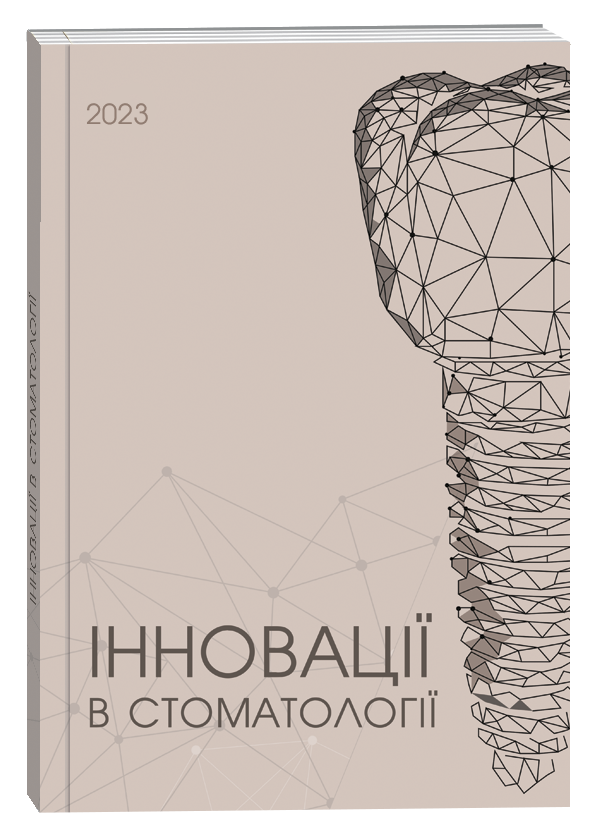РЕЗУЛЬТАТИ ПОРІВНЯЛЬНОЇ КЛІНІЧНОЇ ОЦІНКИ РІЗНИХ МЕТОДІВ РЕСТАВРАЦІЙНОГО ЛІКУВАННЯ ПІДВИЩЕНОГО СТИРАННЯ ТВЕРДИХ ТКАНИН ЗУБІВ
DOI:
https://doi.org/10.35220/2523-420X/2025.1.22Ключові слова:
підвищене стирання зубів, часткові реставрації, композити, діоксид цирконію, CAD/CAM, клінічна ефективністьАнотація
Мета роботи. Порівняти клінічну ефективність часткових прямих композитних та непрямих цирконієвих реставрацій для лікування підвищеного стирання твердих тканин зубів. Методи дослідження. Залучено 30 осіб із генералізованим декомпенсованим підвищеним стиранням твердих тканин зубів І ступеня, змішаної форми, віком до 45 років, серед яких переважали чоловіки (70,0 %). Усі пацієнти були розподілені на 3 дослідні групи по 10 осіб, рівнозначні за статево-віковим складом та клінічною картиною. У першій дослідній групі пацієнтам відновлювали стерті зуби композитним матеріалом прямим методом; у другій – для передніх зубів використовували прямі композитні реставрації, для бокових – overlay-вкладки з діоксиду цирконію, виготовлені із застосуванням CAD/CAM технології. Результати дослідних груп зіставляли з даними контрольної групи, де реставраційне лікування не здійснювалося за згодою з пацієнтами. Обстеження проводили через 1 місяць та 5 років після лікування. Реставрації перевіряли на клінічну прийнятність: функціональність, біологічну відповідність, естетичність. Невдалі реставрації ділили на три категорії: реставрації з серйозними дефектами, що вимагали заміни (F1); реставрації з локалізованими дефектами, що підлягали частковій заміні (F2); реставрації з невеликими дефектами матеріалу, що потребували полірування (F3). За допомогою CAD/CAM програмного забезпечення накладали вихідні та повторні цифрові зображення зубних рядів. Вивчали стирання оклюзійних поверхонь зубів та реставраційна поверхні шістьох зубів: усіх перших молярів та верхніх центральних різців. Міжальвеолярну висоту розраховували в місці розташування перших молярів шляхом аналізу внутрішньоротових сканів зубних рядів.Отримані результати опрацьовували статистично.Наукова новизна. Найбільша клінічна ефективність (97,9 %) розрахована для прямих композитних реставрацій передніх зубів за умови протезування бокових зубів цирконієвими вкладками. При прямому відновленні бокових зубів композитами ефективність фронтальних композитних реставрацій зменшувалася до 93,8 %. Найгірший результат встановлений для прямих композитних реставрацій бокових зубів – 77,5 % проти 88,4 % непрямих цирконієвих вкладок. Стирання твердих тканин зубів за відсутності відновлювального лікування в пацієнтів контрольної групи було достовірно більшим порівняно зі стиранням реставрацій серед дослідних другої групи (Р < 0,05 для композиту та Р < 0,001 – для діоксиду цирконію), а також порівняно з першою групою (Р > 0,05). Стирання бокових зубів перебігало більш інтенсивно аніж передніх (Р > 0,05). Аналогічно зношування композитних реставрацій було більшим для бокових зубів порівняно з передніми (Р < 0,05). Між показниками стирання композитних реставрацій та цирконієвих вкладок, виготовлених для бокових зубів, розрахована найбільша різниця (Р < 0,001). Найсуттєвіша втрата міжальвеолярної висоти встановлена за відсутності реставраційного лікування в пацієнтів контрольної групи (1,52 ± 0,48 мм). Для дослідних першої групи показник втрати міжальвеолярної висоти склав 1,18 ± 0,37 мм (Р > 0,05). У другій групі зниження міжальвеолярної висоти не зареєстровано. Висновки. Реставраційне лікування стертих зубів дозволяє запобігти прогресуванню захворювання. Прямі композитні реставрації передніх і бокових зубів є виправданим методом лікування з малою кількістю серйозних ускладнень. Застосування CAD/CAM технології цирконієвих реставрацій бокових зубів збільшує ефективність лікування у віддалений термін завдяки збереженню міжальвеолярної висоти.
Посилання
Wetselaar, P., Wetselaar-Glas, M. J. M., Katzer, L. D., & Ahlers, M. O. (2020). Diagnosing tooth wear, a new taxonomy based on the revised version of the tooth wear evaluation system (TWES 2.0). J Oral Rehabil, 47(6), 703–712. https://doi.org/10.1111/joor.12972
Shellis, R. P., & Addy, M. (2025). Attrition, abrasion and erosion and their interactions in tooth wear. Monogr Oral Sci, 33, 19–31. https://doi.org/10.1159/000543571
Vailati, F., & Belser, U. (2025). Diagnosis of tooth wear – from erosion to overload. Int J Esthet Dent, 20(2), 112–122.
Dietschi D. (2025). Interceptive treatment of tooth wear. Innovative protocols in treating initial and moderate cases following a biomechanical and risk-factor-oriented strategy. Int J Esthet Dent, 20 (2), 124–139.
Dhaliwal, G., & Ouanounou, A. (2024). Tooth surface loss: causes, management, and prevention. Quintessence Int, 55 (6), 504–513. https://doi.org/ 10.3290/j.qi.b5223649
Loomans, B., Opdam, N., Attin, T., Bartlett, D., Edelhoff, D., Frankenberger, R., Benic, G., Ramseyer, S., Wetselaar, P., Sterenborg, B., Hickel, R., Pallesen, U., Mehta, S., Banerji, S., Lussi, A., & Wilson, N. (2017). Severe tooth wear: European Consensus Statement on Management Guidelines. J Adhes Dent, 19 (2), 111–119. https://doi.org/10.3290/j.jad.a38102
Hardan, L., Mancino, D., Bourgi, R., Cuevas- Suárez, C. E., Lukomska-Szymanska, M., Zarow, M., Jakubowicz, N., Zamarripa-Calderón, J. E., Kafa, L., Etienne, O., Reitzer, F., Kharouf, N., & Haïkel, Y. (2022). Treatment of tooth wear using direct or indirect restorations: a systematic review of clinical studies. Bioengineering (Basel), 9 (8), 346. https://doi.org/10.3390/bioengineering9080346
Ning, K., Bronkhorst, E., Crins, L., van der Meer, W., Pereira-Cenci, T., Yang, F., Leeuwenburgh, S., & Loomans, B. (2022). Wear behaviour of direct composite restorations in tooth wear patients: a 5-year clinical study. J Dent, 127, 104354. https://doi.org/10.1016/j.jdent.2022.104354
Mehta, S. B., Bronkhorst, E. M., Lima, V. P., Crins, L., Bronkhorst, H., Opdam, N. J. M., Huysmans, M. D. N. J. M., & Loomans, B. A. C. (2021). The effect of pre-treatment levels of tooth wear and the applied increase in the vertical dimension of occlusion (VDO) on the survival of direct resin composite restorations. J Dent, 111, 103712. https://doi.org/10.1016/j.jdent.2021.103712
Alani, A., Mehta, S., Koning, I., Loomans, B., & Pereira-Cenci, T. (2025). Restorative options for moderate and severe tooth wear: A systematic review. J Dent, 156, 105711. https://doi.org/10.1016/j.jdent.2025.105711
Crins, L. A. M. J., Opdam, N. J. M., Kreulen, C. M., Bronkhorst, E. M., Sterenborg, B. A. M. M., Huysmans, M. C. D. N. J. M., & Loomans, B. A. C. (2021). Randomized controlled trial on the performance of direct and indirect composite restorations in patients with severe tooth wear. Dent Mater, 37 (11), 1645–1654. https://doi.org/10.1016/j.dental.2021.08.018
Bronkhorst, H., Bronkhorst, E., Kalaykova, S., van der Meer, W., Huysmans, M. C., & Loomans, B. (2022). Precision of in vivo quantitative tooth wear measurement using intra-oral scans. J. Vis. Exp, 12 (185), 63680. https://doi.org/10.3791/63680
Lima, V. P., Crins, L. A. M. J., Opdam, N. J. M., Moraes, R. R., Bronkhorst, E. M., Huysmans, M. D. N. J. M., & Loomans B. A. C. (2022). Deterioration of anterior resin composite restorations in moderate to severe tooth wear patients: 3-year results. Clin Oral Investig, 26(12), 6925–6939. https://doi.org/10.1007/s00784-022-04647-y
Shah, S., Hemmings, K., Gulamali, A., Petrie, A., & Malik, J. S. (2024). The survival and clinical performance of anterior composite resin restorations and posterior indirect and cast restorations used to treat generalised tooth wear. Br Dent J, 237(3), 203–211. https://doi.org/10.1038/ s41415-024-7617-z
Alwadai, G. S., Roberts, G., Ungar, P. S., González- Cabezas, C., Lippert. F., Diefenderfer, K. E., Eckert, G. J., & Hara, A. T. (2020). Monitoring of simulated occlusal tooth wear by objective outcome measures. J Dent, 102, 103467. https://doi.org/10.1016/j.jdent.2020.103467
van Sambeek, R. M. F., Mehta, S. B., Flapper, C., Fokkinga, W. A., Loomans, B. A. C., & Pereira-Cenci, T. (2024). Changes in oral health-related ouality of life after restorative treatment of tooth wear in adult patients: A systematic review. J Dent, 151, 105428. https://doi.org/10.1016/j.jdent.2024.105428
Yar, R. (2023). Digital workflows for the management of tooth wear. Br Dent J, 234 (6), 427–431. https://doi.org/10.1038/s41415-023-5657-4
Caga, D., & Lewis, N. (2021). Treatment of tooth wear associated with reduced occlusal vertical dimension using direct composite restorations and a removable prosthesis. Prim Dent J, 10(1), 120–125. https://doi.org/ 10.1177/2050168420980978.
Attin, T., Schmidlin, P. R., & Tauböck, T.T. (2023). Direct adhesive reconstructions for restoration of posterior teeth with erosive tooth wear. Swiss Dent J, 133 (7–8), 489–495. https://doi.org/10.61872/sdj-2023-07-08-04
Burian, G., Erdelt, K., Schweiger, J., Keul, C., Edelhoff, D., & Güth, J. F. (2021). In-vivo-wear in composite and ceramic full mouth rehabilitations over 3 years. Sci Rep, 11(1), 14056. https://doi.org/10.1038/s41598-021-93425-z
##submission.downloads##
Опубліковано
Як цитувати
Номер
Розділ
Ліцензія

Ця робота ліцензується відповідно до Creative Commons Attribution 4.0 International License.







